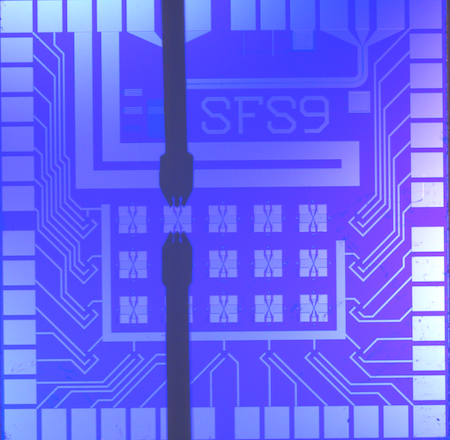Science Fiction
Dictionary
A B C D E F G H I J K L M N O P Q R S T U V W X Y Z
Neuromorphic Computer Offers Non-von Neumann Architecture

Regular computers, while amazing, are not amazing enough for the doughty researchers at the National Institute of Standards and Technology (NIST). They've developed a superconducting “synapse” that “learns” like a biological system.

(NIST’s artificial synapse, designed for neuromorphic computing,
mimics the operation of switch between two neurons. One artificial synapse
is located at the center of each X. This chip is 1 square centimeter in size.
(The thick black vertical lines are electrical probes used for testing.) (credit: NIST))
NIST’s artificial synapse is a metallic cylinder 10 micrometers in diameter — about 10 times larger than a biological synapse. It simulates a real synapse by processing incoming electrical spikes (pulsed current from a neuron) and customizing spiking output signals. The more firing between cells (or processors), the stronger the connection. That process enables both biological and artificial synapses to maintain old circuits and create new ones.NIST’s artificial synapse is a metallic cylinder 10 micrometers in diameter — about 10 times larger than a biological synapse. It simulates a real synapse by processing incoming electrical spikes (pulsed current from a neuron) and customizing spiking output signals. The more firing between cells (or processors), the stronger the connection. That process enables both biological and artificial synapses to maintain old circuits and create new ones.
Operating at 100 GHz, it can fire at a rate that is much faster than the human brain — 1 billion times per second, compared to a brain cell’s rate of about 50 times per second.
It uses only about one ten-thousandth as much energy as a human synapse. The spiking energy is less than 1 attojoule** — roughly equivalent to the miniscule chemical energy bonding two atoms in a molecule — compared to the roughly 10 femtojoules (10,000 attojoules) per synaptic event in the human brain. Current neuromorphic platforms are orders of magnitude less efficient than the human brain. “We don’t know of any other artificial synapse that uses less energy,” NIST physicist Mike Schneider said.
Science fiction fans recall that Isaac Asimov, in his short story Reason, wrote about a similar idea:
All that had been done in the mid 20th century on "calculating machines" had been upset by Robertson and his positronic brain paths. The miles of relays and photocells had given way to the spongy globe of platinum iridium about the size of the human brain. (Read more about the positronic brain)
A few years later, Philip K. Dick had fun with the idea of a Nexus-6 brain unit in his 1968 novel Do Androids Dream of Electric Sheep:
The Nexus-6 did have two trillion constituents plus a choice within a range of ten million possible combinations of cerebral activity. In .45 of a second an android equipped with such a brain could assume any one of fourteen basic reaction-postures. Well, no intelligence test could trap such an andy. But then, intelligence tests hadn't trapped an andy in years, not since the primordial, crude varieties of the 1970's.
Don't forget about the electronic analog of living brain from Frederik Pohl's The Tunnel Under the World.
Via KurzweilAI.
Scroll down for more stories in the same category. (Story submitted 2/3/2018)
Follow this kind of news @Technovelgy.| Email | RSS | Blog It | Stumble | del.icio.us | Digg | Reddit |
Would
you like to contribute a story tip?
It's easy:
Get the URL of the story, and the related sf author, and add
it here.
Comment/Join discussion ( 0 )
Related News Stories - (" Computing ")
Neuromorphic Computer Offers Non-von Neumann Architecture
Fires faster than brain at 1/10K energy.
Technovelgy (that's tech-novel-gee!) is devoted to the creative science inventions and ideas of sf authors. Look for the Invention Category that interests you, the Glossary, the Invention Timeline, or see what's New.
Science Fiction
Timeline
1600-1899
1900-1939
1940's 1950's
1960's 1970's
1980's 1990's
2000's 2010's
Current News
Proof Of Robothood - Not A Person
'Who are you people? - Show 'em.'
Dancing Robots Taught Dance Moves
'A clockwork figure would be the thing for you...'
Indonesian Clans Battle
'The observation vehicle was of that peculiar variety used in conveying a large number of people across rough terrain.'
The 'Last Mile' In China Crowded With Delivery Robots
Yes, it's a delivery robot. On wheels.
Tornyol Microdrone Kills Mosquitoes
'The real border was defended by... a swarm of quasi-independent aerostats.'
PLATO Spacecraft, Hunter Of Habitable Planets, Now Ready
'I ... set my automatic astronomical instruments to searching for a habitable planet.'
Factory Humanoid Robots Built By Humanoid Robots
'...haven't you a section of the factory where only robot labor is employed?'
iPhone Air Fulfils Jobs' Promise From 2007 - A Giant Screen!
'... oblongs were all over the floor and surfaces.'
ChatGPT Now Participates in Group Chats
'...the city was their laboratory in human psychology.'
iPhone Pocket All Sold Out!
'A long, strong, slender net...'
Did The Yautja Have These First?
What a marvel of ingenuity the little device was!
Jetson ONE Air Races Begin, Can Air Polo Be Far Behind?
'If you're one of those rarities who haven't attended a rocket-polo "carnage", let me tell you it's a colorful affair.'
Will Space Stations Have Large Interior Spaces Again?
'They filed clumsily into the battleroom, like children in a swimming pool for the first time, clinging to the handholds along the side.'
Mornine Sales Robot
'Robot-salesmen were everywhere, gesturing...'
Bipedal Robot Floats Gently While Walking
'a walking balloon proceeded with long strides of its aluminum legs...'
Musk Idea Of Cars Talking To Each Other Predicted 70 Years Ago
'My cars talk to one another.'
